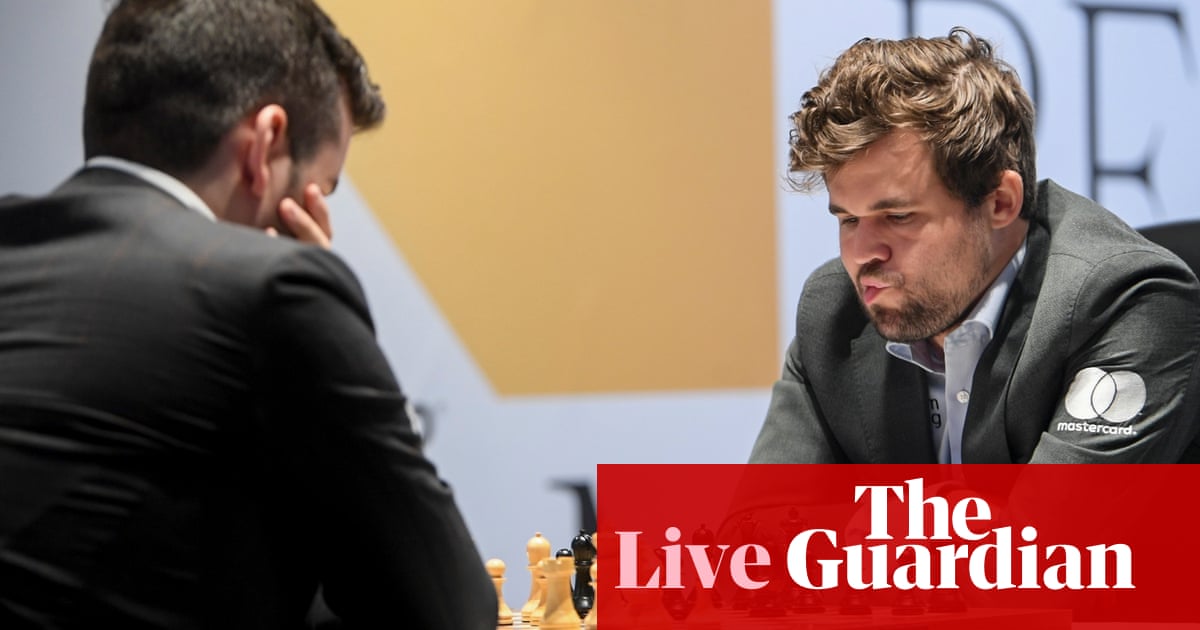Carlsen is asked he agrees with Nepomniachtchi’s assessment that his style for the match was surprisingly conservative. Was this a predetermined choice or an organic response to the positions he was given?
“I think a bit of both,” the champion says. “I definitely played a lot more conservatively as black than I did in the match against Fabi (in 2018). With white, I wouldn’t necessarily say that I was that conservative. I was at least trying some different lines, trying to play. But you can see overall in a lot of my decision, when push came to shove, skewed conservative. With hindsight it worked pretty well.”
Carlsen is asked if he was at all disappointed the match didn’t live up to its competitive expectations. “No, that’s fine by me,” he says with a smile. “I think Game 6 was excellent. Regardless of the quality of all the moves, it was a great fight. I guess it just decided everything. That’s mainly what I’m taking away from an excitement perspective. Otherwise at a certain point, your best strategy can be to just wait knowing that you have the lead and just be very serious and solid and that can sometimes be the best way to play for a win as well.”
“I guess it’s the most similar with my first match with Anand (in 2013), which was quite even and nervous at the start,” Carlsen says. “And when I got my first win it was kind of the same story: it was relatively clean from there on out. What can I say? Obviously [Nepomniachtchi] couldn’t at some point show his best chess, which is a pity for the excitement in the match. But I think that’s what happens sometimes when you get in a difficult situation. Then all of that preparation and everything doesn’t necessarily help if you can’t cope at the moment.”
“These things which happened here, they have never happened to me at basically any events,” Nepomniachtchi says of his fatal blunders in the eighth, ninth and 11th games. “In my career I lost quite some stupid games but not as many in such a (short) time.”
Asked if he will turn his focus toward the next candidates tournament and a repeat challenge to Carlsen at the next world championship: “Of course it’s possible to think but for now it would be more clever, more smart to take some time and have some rest.”
“No ideas,” says Nepomniachtchi when asked if he can put a finger on what went wrong. “If I would have known what was going on I would surely have fixed it during the match.”
He continues: “Experience is never easy. ... The situation should be tough to gain some real experience. I guess it was a little bit too much here. I surely have some space to improve and perhaps solving some puzzles would fix it, (then) in the upcoming events I would show some better performance.”
“I didn’t expect it go quite like this,” Carlsen says at the post-game presser. “I think it was just a very good professional performance overall. No regrets at all, just very satisfied.”
He adds: “After five games there were five draws and I’d had very, very few chances to play for anything more. Then everything kind of clicked and after that it all went my way. You don’t expect to necessarily run away with it in a world championship.”
Says Nepomniachtchi: “The match of course consists of many aspects. It’s not only chess preparation but physical and psychological preparation. Of course it’s really tense and it’s a little more tense than I expected. But I guess anyway the tension is not a reason to overlook some simple things you would never overlook in a blitz game. What can I say? I should find out why it did happen and improve.”
“I’m relieved of course,” Carlsen says immediately after exiting the playing studio. “It’s hard to feel that great joy when the situation was so comfortable to begin with, but I’m happy with a very good performance overall.”
Asked to assess his performance over the course of the match, Carlsen says: “You can point that things you could have done different in every game of course, but overall I’m happy with my play, very proud of my effort in the sixth game, and that sort of laid the foundation for everything. The final score is probably a bit more lopsided than it could have been, but that’s the way I think some of the other matches also could have gone if I had gotten a lead.”
Where does this match rank among his previous four world championship victories: over Anand in 2013 and 2014, Karjakin in 2016 and Caruana in 2018?
“It’s hard to say,” he says. “The last one is always in a way the sweetest but I’m just happy to have won.”
And it’s over! Ian Nepomniachtchi resigns after 49 moves and 3hr 21min and the imperious Magnus Carlsen confirmed his supremacy by retaining the world championship with a fourth win over Russia’s Ian Nepomniachtchi in the 11th game of their €2m ($2.26m) showdown in Dubai.
Bryan Armen Graham (@BryanAGraham)The moment Magnus Carlsen captured his fifth world championship, finishing off the most one-sided title match since Capablanca’s win over Lasker exactly 100 years ago in Havana. pic.twitter.com/APB9XDLhbI
December 10, 2021
Carlsen has promoted his h-pawn to a queen after 41. ... h3 42. Kxc7 h2 43. Rb1 Rxc3+ 44. Kxb6 Rb3+ 45. Rxb3 h1=Q. A few more moves follow: 46. a5 Qe4 47. Ka7 Qe7+ 48. Ka8 Kg7. Not much longer now.
Carlsen goes below six minutes after 38. ... h5 39. Kd5 Rc2 40. Rb3. But he plays 40. ... h4 to comfortably reach the time control. Nepomniachtchi quickly responds with 41. Kc6. The world championship match could be decided within moments.
It’s still winning for Carlsen after 34. ... Rd2 35. Rb1 g6 36. b4 axb4 37. Rxb4 Ra2 38. Ke4. But that leaves the Norwegian with less than 16 minutes to make his next three moves – the players gain an extra hour on the clock after move 40 under the format – while Nepomniachtchi has more than 51 minutes on his clock.
The queens come off along with white’s rook and black’s knight: 32. Kxg2 Nxe1+ 33. Rxe1 Rxd6 34. Kf3. That leaves us with a rook endgame with an extra pawn for black. “He could have finished this game much earlier,” Caruana says from the booth. “He’s probably a bit annoyed that it’s still lasting.”
Carlsen is taking his time. He spends more than 10 minutes before playing 27. ... Nh4. A bit of nerves from the champion at the final hurdle as he misses the coup de grâce (cxd6), but he is still winning. Nepomniachtchi takes a pawn (28. fxe3) and Carlsen moves in with 28. ... Qg3+ followed by 29. Kf1 Nf3 30. Qf2 Qh3+. The Norwegian still has the win in hand but it looks to be headed for a rook endgame.
Olimpiu G. Urcan (@olimpiuurcan)He's not a computer after all. 27...Nh4, instead of the cold-blooded 27...cxd6. pic.twitter.com/yzKdxchqeS
December 10, 2021
Carlsen plays the winning 26. ... Nf5. The game and match is but a handshake away. Nepomniachtchi plays 27. d6 to block the rook’s entry into the affair but there’s no escape.
This will likely go down as the most lopsided world championship match since José Raúl Capablanca’s triumph over Emanuel Lasker exactly 100 years ago in Havana. In that match, Capablanca won by a four-game margin without a single defeat – a stunning beatdown Carlsen is moments away from matching.
Carlsen’s fifth world title is surely within touching distance now. “It’s clear to anyone with eyes that this is a disaster,” Dutch grandmaster Anish Giri says of the Norwegian champion. “He just broke the guy. He broke him with his solid moves.”
Nepomniachtchi attacks black’s rook with 23. g3. It’s a blunder! Oh dear! This leaves Carlsen in a place where he must find the correct response (dxe3) or he’s losing. And he’s found it after 79 seconds: 23. ... dxe3. This will sacrifice his rook but leave white’s queen badly exposed. This is winning for black and barring something extraordinary, Carlsen will be retaining his world title today.
Nothing changes over the next sequence of moves: 23. ... dxe3 24. gxf4 Qxg4+ 25. Kf1 Qh3+ 26. Kg1.
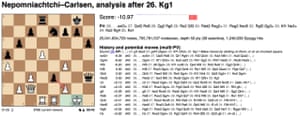
Carlsen spends nearly 11 minutes before capturing on the d4 square (20. ... exd4). Nepomniachtchi strolls back to the board, quickly captures with 21. exd5 and leaves again. After a minute Carlsen moves his rook out of danger to the center, guarding his d-pawn (21. ... Re4). Now Carlsen walks away from the board as well, leaving both chairs empty.
Nepomniachtchi returns to retreat the queen and hits the black rook with 22. Qc2. Carlsen moves his rook over with 22. ... Rf4. Both players are back in their chairs looking at this position. The champion must be satisfied with how he’s handled Nepomniachtchi’s pressure, leaving the challenger with no clear path to a desperately needed win as white.
“[Nepomniachtchi’s] body language is disappointed now,” Caruana says from the commentary booth. “I think he realizes that there’s no chance to play for an adavntage. He probably thought that he was still playing for an advantage with this (20. d4) tactic that he had.”
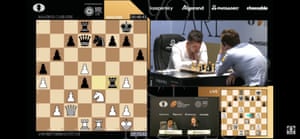
And Carlsen indeed goes for the trade of knights with 18. ... Nxg4. Nepomniachtchi recaptures with his h-pawn (19. hxg4). Why upset the pawn structure rather than take with the knight? Says three-time British champion on Chess24’s broadcast: “If the knight captures, although the knight is further up the board, it’s also on a more vulnerable square. Ian wanted to recapture with (the h-pawn) because he feels this structure is more promising. this (h-pawn) now controls the f5 square that the white knight might want to use later on.”
Carlsen quickly responds with 19. ... d4 and Nepomniachtchi after a minute and a half follows with the 20. d5. A quite sharp position with the four pawns staring at each other in the center of the board. “It’s either going to very, very strong for Ian,” Howell says, “or these four pawns will disappear and everything will get traded and it will just be a draw.”
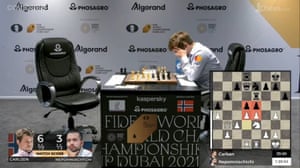
Nepomniachtchi spends nearly six minutes before moving his knight back (17. Nh2) with apparent designs on the g4 square. Carlsen responds with 17. ... Rd8 and indeed the challenger follows with 18. Nhg4 before immediately stepping away from the board. Will Carlsen trade knights (Nxg4) or keep the tension with playable alternatives like Nh5, Ne8 or Ng6? Also in play: the h5 pawn push.
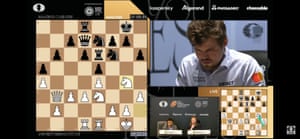
Nepomniachtchi plays 15. Rad1 after seven and a half minutes. Carlsen responds with 15. ... Ne7 before the build-up continues with 16. h3 Qd7.
Some breaking chess news from Dubai: Fide’s general director Emil Sutovsky has just confirmed the World Rapid & Blitz Chess Championships, initially scheduled to take place from 25-31 December in Kazakhstan but scuttled due to the government’s new Covid restrictions, will now take place in Warsaw on the same dates.
Carlsen plays 14. ... b6. “It’s not much of an advantage (for white),” says the American grandmaster Fabiano Caruana on Chess.com’s broadcast. “Magnus is super stable, especially in these types of positions. He doesn’t do any anti-positional things or make any serious mistakes, so it’s really hard to beat him in this type of position. But it’s also modern chess. Theory has developed to the point that black players can play solidly. Let’s say Magnus with the black pieces: he can play as solidly as he wants and this is the extent of the advantage you’re going to get against him.”
Caruana continues: “If you want to win the game, either [Carlsen] takes risks early on. He plays some slightly riskier stuff with black. Or you should be content with an advantage of this nature where you know you’re not going to win immediately, but it’s a long game and you try to slowly outplay him and make the most of your chances. You’re not going to blow someone off the board these days at the top level.”
More deep thought. Carlsen has been mulling this position in response to Nepomniachtchi’s 14. Qb3 for eight minutes (and counting).
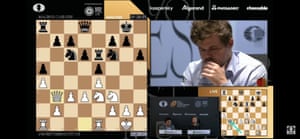
Carlsen spends more than 14 minutes before opting to exchange dark-square bishops (10. ... Bxe3 11. Nxe3). As predicted, the champion moves his rook over (11. ... Re8) before Nepomniachtchi gains space on the queenside with 12. a4. After this sequence, the players are level on time.
Nepomniachtchi finally plays 9. Nc2 after nearly 18 minutes. Carlsen immediately castles (9. ... O-O) and the challenger answers with 10. Be3, the first new move of today’s game. Early days but Nepomniachtchi is already more than 10 minutes behind on the clock.
Nepomniachtchi has been pondering his response to 8. ... h6 for more than 16 minutes. The Italian Game has been played only six times in the centuries-spanning annals of world championship matchplay and not since 1981. And 3. ... Nf6 hasn’t been played in 129 years.
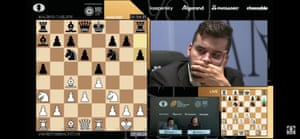
A fascinating twist to today’s Italian Game (7. ... Ba7 8. Na3). Carlsen takes three minutes before responding with 8. ... h6. Only two known games follow this line in the database. Nepomniachtchi has been considering his response for eight minutes (and counting) as Carlsen has stepped away from the board.
And 1. e4 is on the board. No English Opening for Nepomniachtchi today. And we’re into the Italian (1. ... e5 2. Nf3 Nc6 3. Bc4) as the players blitz out their opening moves: 3. ... Nf6 4. d3 Bc5 5. c3 d6 6. O-O a5 7. Re1 Ba7 8. Na3.
Our Leonard Barden has filed his latest dispatch ahead of today’s 11th game. Barden, who’s written the Guardian’s chess column every week since September 1955, puts a positive spin on Nepomniachtchi’s fall in Dubai.
Nepomniachtchi may be down and almost out, but he is assured a place in the eight-player 2022 Candidates. If he wins that, then historical parallels – Vasily Smyslov in 1954 and 1957, Boris Spassky in 1966 and 1969, and Garry Kasparov in 1984 and 1985 – suggest that he will have benefited from the harsh learning experience to make a much better fight at a second attempt. Of course, a second shot is far from guaranteed, and any of Alireza Firouzja, Ding Liren or Caruana will be more likely contenders.
For Carlsen, barring an unlikely slip-up this weekend, the outcome provides the most convincing match performance of his four championship defences since 2014, and edges him closer to becoming generally accepted as the all-time No 1 ahead of Kasparov and Bobby Fischer.
The joker in the pack remains Carlsen’s repeated hints that at some stage he will retire from Fide title competition and only take part in a series, akin to the online Champions Tour, where games at two-hour rapid rather than four-hour classical become the norm. Could that happen as early as next week? It seems unlikely, given that in the next few years there will be a growing public demand for a Carlsen v Firouzja championship match at classical time rates.
Hello and welcome back for the 11th game of the World Chess Championship. The overall score in the €2m ($2.26m) showdown between Magnus Carlsen and Ian Nepomniachtchi is 6½-3½ to Carlsen after the Norwegian’s breakthrough wins in Game 6, Game 8 and Game 9.
That means Carlsen could finish off his fourth successful defense of the title as soon as today with a wan.
On Wednesday, Carlsen and Nepomniachtchi played to a quiet 41-move draw at the Dubai Exhibition Centre. Less than 24 hours after the Russian challenger missed made an extraordinary blunder from a promising position to effectively seal his fate in the best-of-14 match, Nepomniachtchi appeared willing to settle for a peaceful result before making one final push today.
“At this point, there’s so few games to go that any draw is an excellent result,” Carlsen said.
We’re about 20 minutes from today’s first move with Nepomniachtchi set to marshal the white pieces.
Bryan will be here shortly. In the meantime here’s his report from Wednesday’s 10th game in Dubai, which leaves Magnus Carlsen one point from retaining his world championship today.

